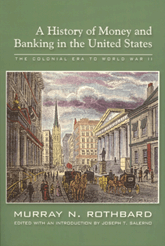History of Money and Banking in the United States
 |
|
| Author | Murray Rothbard |
|---|---|
| Country | United States |
| Language | English |
| Subject |
Politics Economics Gold Standard Federal Reserve |
| Publisher | Ludwig Von Mises Institute |
|
Publication date
|
August 30, 2002 |
| Media type | Hardcover |
| Pages | 510 |
| ISBN | |
| OCLC | 51205107 |
A History of Money and Banking in the United States is a 2002 book by economist Murray Rothbard.
From the introduction by Joseph Salerno:
In this volume, Murray Rothbard has provided a comprehensive history of money and banking in the United States, from colonial times to World War II, the first to explicitly use the interpretive framework of the Austrian monetary theory…Although its five parts were written separately, this volume presents a relatively integrated narrative, with very little overlap, that sweeps across three hundred years of U.S. monetary history.
Part 1, "The History of Money and Banking Before the Twentieth Century", consists of Rothbard’s contribution to the minority report of the U.S. Gold Commission and treats the evolution of the U.S. monetary system from its colonial beginnings to the end of the nineteenth century. In this part, Rothbard gives a detailed account of two early and abortive attempts by the financial elites to shackle the young republic with a quasi-central bank. He demonstrates the inflationary consequences of these privileged banks, the First and Second Banks of the United States, during their years of operation, from 1791 to 1811 and from 1816 to 1833, respectively. Rothbard then discusses the libertarian Jeffersonian and Jacksonian ideological movements that succeeded in destroying these statist and inflationist institutions. This is followed by discussions of the era of comparatively free and decentralized banking that extended from the 1830s up to the Civil War, and the pernicious impact of the war on the U.S. monetary system. Part 1 concludes with an analysis and critique of the post–Civil War National Banking System. Rothbard describes how this regime—which was aggressively promoted by the investment banking firm that had acquired the monopoly of underwriting government bonds—centralized banking and destabilized the economy, resulting in a series of financial crises that prepared the way for the imposition of the Federal Reserve System.
Part 2 on "Origins of the Federal Reserve" is a paper that lay unpublished for a long time and appeared in an issue of The Quarterly Journal of Austrian Economics.
Part 3 contains a formerly unpublished paper, "From Hoover to Roosevelt: The Federal Reserve and the Financial Elites." Here, Rothbard identifies the financial interests and ideology that drove the Fed to engineer an almost uninterrupted expansion of the money supply from the moment of its inception in 1914 through 1928. This part also includes an analysis of how concordance and conflict between the Morgan and Rockefeller financial interests shaped the politics and behavior of the Fed during the Hoover administration and the first Roosevelt administration as well as international monetary and domestic banking and financial policies under the latter administration.
...
Wikipedia
